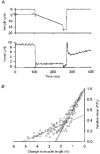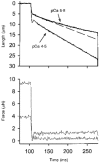Force-velocity and power-load curves in rat skinned cardiac myocytes
- PMID: 9706028
- PMCID: PMC2231141
- DOI: 10.1111/j.1469-7793.1998.519bh.x
Force-velocity and power-load curves in rat skinned cardiac myocytes
Abstract
1. This study utilized a skinned myocyte preparation with low end compliance to examine force-velocity and power-load curves at 12 C in myocytes from rat hearts. 2. In maximally activated myocyte preparations, shortening velocities appeared to remain constant during load clamps in which shortening took place over a sarcomere length range of approximately 2.30-2.00 micro m. These results suggest that previously reported curvilinear length traces during load clamps of multicellular preparations were due in part to extracellular viscoelastic structures that give rise to restoring forces during myocardial shortening. 3. During submaximal Ca2+ activations, the velocity of shortening at low loads slowed and the time course of shortening became curvilinear, i.e. velocity progressively slowed as shortening continued. This result implies that cross-bridge cycling kinetics are slower at low levels of activation and that an internal load arises during shortening of submaximally activated myocytes, perhaps due to slowly detaching cross-bridges. 4. Reduced levels of activator Ca2+ also reduced maximal power output and increased the relative load at which power output was optimal. For a given absolute load, the shift has the effect of maintaining power output near the optimum level despite reductions in cross-bridge number and force generating capability at lower levels of Ca2+.
Figures








Similar articles
-
Ca2+ dependence of loaded shortening in rat skinned cardiac myocytes and skeletal muscle fibres.J Physiol. 2000 May 15;525 Pt 1(Pt 1):169-81. doi: 10.1111/j.1469-7793.2000.00169.x. J Physiol. 2000. PMID: 10811735 Free PMC article.
-
Myosin binding protein-C modulates loaded sarcomere shortening in rodent permeabilized cardiac myocytes.J Gen Physiol. 2025 May 5;157(3):e202413678. doi: 10.1085/jgp.202413678. Epub 2025 Mar 24. J Gen Physiol. 2025. PMID: 40126337
-
Effects of calcium on shortening velocity in frog chemically skinned atrial myocytes and in mechanically disrupted ventricular myocardium from rat.Circ Res. 1992 May;70(5):885-92. doi: 10.1161/01.res.70.5.885. Circ Res. 1992. PMID: 1568299
-
The interdependence of Ca2+ activation, sarcomere length, and power output in the heart.Pflugers Arch. 2011 Jul;462(1):61-7. doi: 10.1007/s00424-011-0949-y. Epub 2011 Mar 15. Pflugers Arch. 2011. PMID: 21404040 Free PMC article. Review.
-
Sarcomere mechanics in uniform and non-uniform cardiac muscle: a link between pump function and arrhythmias.Prog Biophys Mol Biol. 2008 Jun-Jul;97(2-3):312-31. doi: 10.1016/j.pbiomolbio.2008.02.013. Epub 2008 Feb 15. Prog Biophys Mol Biol. 2008. PMID: 18394686 Review.
Cited by
-
High efficiency preparation of skinned mouse cardiac muscle strips from cryosections for contractility studies.Exp Physiol. 2020 Nov;105(11):1869-1881. doi: 10.1113/EP088521. Epub 2020 Sep 16. Exp Physiol. 2020. PMID: 32857888 Free PMC article.
-
Sarcomere length dependence of power output is increased after PKA treatment in rat cardiac myocytes.Am J Physiol Heart Circ Physiol. 2009 May;296(5):H1524-31. doi: 10.1152/ajpheart.00864.2008. Epub 2009 Feb 27. Am J Physiol Heart Circ Physiol. 2009. PMID: 19252095 Free PMC article.
-
A quantitative analysis of cardiac myocyte relaxation: a simulation study.Biophys J. 2006 Mar 1;90(5):1697-722. doi: 10.1529/biophysj.105.069534. Epub 2005 Dec 9. Biophys J. 2006. PMID: 16339881 Free PMC article.
-
Substrate stiffness affects the functional maturation of neonatal rat ventricular myocytes.Biophys J. 2008 Oct;95(7):3479-87. doi: 10.1529/biophysj.107.124545. Epub 2008 Jun 27. Biophys J. 2008. PMID: 18586852 Free PMC article.
-
Distinct sarcomeric substrates are responsible for protein kinase D-mediated regulation of cardiac myofilament Ca2+ sensitivity and cross-bridge cycling.J Biol Chem. 2010 Feb 19;285(8):5674-82. doi: 10.1074/jbc.M109.066456. Epub 2009 Dec 17. J Biol Chem. 2010. PMID: 20018870 Free PMC article.
References
-
- Brady AJ. Mechanical properties of isolated cardiac myocytes. Biological Reviews. 1991;71:413–428. - PubMed
-
- Brenner B. Calcium activation and maximum unloaded shortening velocity. Investigations on glycerinated skeletal and heart muscle preparations. Basic Research in Cardiology. 1980;75:40–46. - PubMed
-
- Brenner B. The necessity of using two parameters to describe isotonic shortening velocity of muscle tissues: The effect of various interventions upon initial shortening velocity (vi) and curvature (b) Basic Research in Cardiology. 1986;81:54–69. - PubMed
-
- Brutsaert DL, Claes VA, Goethals MA. Effect of calcium on force-velocity relations of heart muscle of the cat. Circulation Research. 1973;32:385–392. - PubMed
Publication types
MeSH terms
Grants and funding
LinkOut - more resources
Full Text Sources
Other Literature Sources
Miscellaneous

